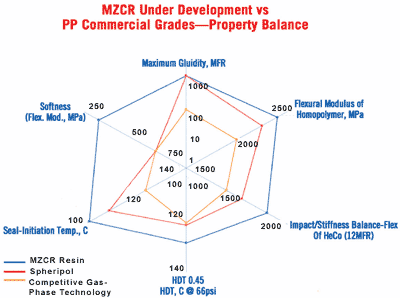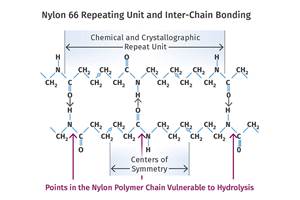New Process Makes More Homogeneous PP Homopolymers & Copolymers
New styles of resin reactors don’t come along very often.
New styles of resin reactors don’t come along very often. But some time in the next three months, Basell Polyolefins plans to start up in Bridisi, Italy, the first commercial-scale unit employing a brand-new, gas-phase loop technology. It is said to be unique in making highly homogenous multi-monomer resins or bimodal homopolymers in a single reactor.
Basell, whose U.S. offices are in Wilmington, Del., calls it the Multi-Zone Circulating Reactor (MZCR). It consists of a 120-ft-tall continuous loop of gas divided into two zones by a liquid monomer barrier that is held in place by tightly packed polymer particles. The different zones accomplish what other processes do with multiple gas-phase and slurry-loop reactors.
In the single MZCR reactor, the first zone starts out rich in propylene monomer (and a comonomer, if desired). The second zone is rich in hydrogen gas, and the high-velocity gas flow spreads the growing resin particles out more loosely. The two zones produce resins of different molecular-weight and/or monomer composition. Polymer granules grow as they travel round and round this loop, building up alternating layers of each polymer fraction like an onion. Each particle is thus an intimate combination of both polymer fractions.
The particles pass quickly up through the fluidizing gas in the “riser” side of the loop and come slowly down through the liquid monomer on the “down” side. Different monomers can be added in the two reactor legs. The reactor can use both conventional and single-site catalysts.
In the liquid/gas separation zone, the hydrogen gas is stripped off to cool and recirculate. Polymer granules are then densely packed into the “plug flow” section, through which they descend slowly. Monomers are introduced as liquids in this section. Conditions in the liquid-propylene plug-flow section can be varied with different combinations of monomers or different proportions of comonomer to propylene monomer in successive passes.
In-situ polymer blends
Basell claims that the resulting material combinations are more homogeneous and more easily processable than those made by conventional multi-reactor series. Resins are said to have fewer gels and to require less energy to extrude and pelletize. “Short chains and long chains can apparently be more intimately incorporated into the polymer, preserving the homogeneity of the resin,” says Dr. William D. Vernon of Chemical Market Resources Inc., a Houston-based polymer-industry research firm, in a review of the new reactor technology.
This unique loop reactor can make PP copolymers, terpolymers, and bimodal homopolymers, including some previously possible only with an elaborate series of reactors. The MZCR technology produces more homogeneous comonomer distribution than these multiple reactor series because each MZCR particle is an intimate blend of both material fractions, Basell says.
The MZCR reactor represents a further step beyond Basell’s multi-reactor Catalloy process, which was previously the only in-situ way to make PP copolymers with high ethylene-rubber content for automotive parts, roofing membranes, and films that combine high stiffness and high impact . MZCR can also produce in-reactor blends of homopolymer and random copolymer or of two random copolymers.
According to Basell’s patents, MZCR reactors can make HDPE homo- and copolymers, LLDPE with 0.88 to 0.94 g/cc density, EPDM, impact PP, and PP copolymers with ethylene or other alpha-olefins.
The MZCR loop can also be paired with a Basell gas-phase reactor downstream to make heterophasic copolymers with higher impact/stiffness balance or greater softness than are made with other processes. As an example of what MZCR can do, a researcher cites a 12-MFR resin with notched Izod impact of 1.4 ft-lb/in. Tensile modulus is around 261,000 psi with MZCR vs. about 232,000 psi for a similar resin made with the latest-generation Spheripol reactor.
Wide licensing possible
Once Basell’s commercial trials are completed, MZCR has the potential for wide adoption by the company’s licensees because it can be retrofitted into existing Spheripol plants. The plants could continue to make Spheripol products as well as new materials. Spheripol is the most widely used process to make PP in the world, accounting for over 35% of global production, according to Chemical Market Resources. MZCR offers cost savings to resin producers because the catalyst yields twice as much output and grade changes are faster.
Related Content
Lanxess and DSM Engineering Materials Venture Launched as ‘Envalior’
This new global engineering materials contender combines Lanxess’ high-performance materials business with DSM’s engineering materials business.
Read MoreICIS Launches: Ask ICIS Generative AI Commodities Assistant
Said to be the first of its kind, this AI assistant will enhance access to ICIS’ intelligence and insights for the energy and chemical markets.
Read MorePrices for All Volume Resins Head Down at End of 2023
Flat-to-downward trajectory for at least this month.
Read MoreWhat is the Allowable Moisture Content in Nylons? It Depends (Part 1)
A lot of the nylon that is processed is filled or reinforced, but the data sheets generally don’t account for this, making drying recommendations confusing. Here’s what you need to know.
Read MoreRead Next
See Recyclers Close the Loop on Trade Show Production Scrap at NPE2024
A collaboration between show organizer PLASTICS, recycler CPR and size reduction experts WEIMA and Conair recovered and recycled all production scrap at NPE2024.
Read MoreBeyond Prototypes: 8 Ways the Plastics Industry Is Using 3D Printing
Plastics processors are finding applications for 3D printing around the plant and across the supply chain. Here are 8 examples to look for at NPE2024.
Read MoreLead the Conversation, Change the Conversation
Coverage of single-use plastics can be both misleading and demoralizing. Here are 10 tips for changing the perception of the plastics industry at your company and in your community.
Read More















